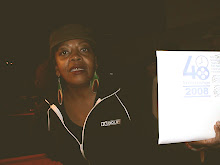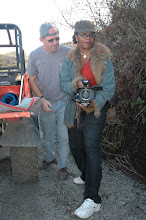“Innovation happens when people with vision are forced to build something to realize their goals, because it doesn’t already exist.” – Jeff Gomez
The future of independent moviemaking is bright. As it stands at an undefined but utterly crucial precipice: Funding has vanished and distribution has become manic. The old and big structures are tumbling down. It is a very exciting time, and there are no rules. People haven’t figured it all out yet because “small & independent” happened so fast. The only certainty is that new paths are being forged all the time.
The major studio system is being replaced by several hundred thousand micro-studios that will serve audiences better than the majors could, because a micro-studio film industry is one based on passion. In this new landscape of things to come, there are those innovators primed to lead the charge of this new indie revolution. The industry is being fortified with fresh ideas and is safely being guided through the foggy landscape so that it emerges on the other side in better shape. It is becoming clearer that the future dictates what it means to be a moviemaker as production and distribution values force more and more creative solutions.
BIG v.s. SMALL
Seth Godin says “Big” used to matter. Big meant economies of scale. (You never hear about “economies of tiny” do you?) Hollywood and Fortune 500 used to be the place people went to make a fortune. The reason being, value was added in ways that big organizations were good at. Value was added with efficient manufacturing, widespread distribution and very large R&D staffs. Value came from hundreds of operators standing by and from nine-figure TV ad budgets. Value also came from a huge sales force.
GET BIG FAST was the motto for startups, because big companies and big film productions can go public and get more access to capital and use the capital to get even bigger. Big accounting firms were the place to go to get audited if you were a big company, because a big accounting firm could be trusted. Big law firms were the place to find the right lawyer because big law firms were a one-stop shop.
And then small happened.
Enron (big) got audited by Andersen (big) and failed (big.) The World Trade Center was a target. TV advertising is collapsing fast. The writers strike in Hollywood took out a lot of the normal night time TV programming and was replaced with Reality Shows. American Airlines (big) got slammed dunked by Jet Blue (think small). BoingBoing (four people) grew a readership a hundred times faster than the New Yorker (hundreds of people.) In 2006, Craigslist (18 employees) was the fourth most visited site according to some measures.
Seth says the following about small:
• Small is the new big because small gives you the flexibility to change the business model when your competition changes theirs.
• Small also means you can tell the truth on your blog.
• Small means that you can answer email from your audiences and customers.
• Small means that you will outsource the boring, low-impact stuff like manufacturing and shipping and billing and packing to others, while you keep the power because you invent the remarkable and tell stories to people who want to hear them.
• A small law firm or accounting firm or ad agency is succeeding because they’re good, not because they’re big. So smart small companies are happy to hire them.
• A small restaurant has an owner who greets you by name.
• A small venture fund doesn’t have to fund big bad ideas in order to get capital doing work. They can make small investments in tiny companies with good (big) ideas.
• Small is the new big only when the person running the small thinks big. Don’t wait, get small to think big.
The Format Is A Container – Self-Distribution
If you wait around for that great “one” you don’t get better. Short (small) films allow you to learn more and get better. You work things out over time. For example, “do I want to light this way or that way.”
It is important to build a relationship with people to engage with you and your company/team. Think of self-distribution of your own movies.
One of the easiest ways to get fans is to put your film in as many formats as possible. At the least make five different formats to include a give away DVD. You can start by putting it in your blog as an RSS attachment. You lose if you make it hard to get. It needs to convince people to come back. This tells a story or your idea as a story. Selecting topics that are not totally explored makes people come back to see how things get resolved. Give them a reason to come back.
There are increasingly more new ways to distribute your media. First consider who your audience is. With the various Internet distribution outlets, including YouTube, it is incredibly easy to find an audience for your work. The key is to let people choose how they want to experience a film, when and on which platform.
Access to inexpensive, yet high quality filmmaking has never been better. As an independent producer, the question to ask yourself is: How best can I make it easier for people to download my work and look at. Then, build up an audience from one of the many communities around the world that are connected by common interest (that you can eventually make money off) by producing good content and letting people download it. Consider viral marketing; i.e., people passing on videos to their friends (at least ten people). If you can do a video show that fans think is so good that you get a natural viral audience that’s done organically, you end up with a small scale production with a large scale audience and get fans and evangelists to spread the word in getting your production to the right people and audience that likes what you’re doing with minimal resources by getting it in the right spot.
You can release your mini-masterpiece via TubeMogul.com, which spits them to all the important video sites including YouTube, MySpace, Vimeo, Viddler, blips and a few others. They usually want to buy a DVD from you. This is a great way to build an audience because your giving it away is getting it exposed to more people.
Pre-Promotion & Niche Marketing
Think about your product in terms of final audience by asking yourself who wants to see it and what about mine that would make others watch it and share it with their friends and how I can make it so that it satisfies more people.
Communicating your passion to a community of those who have the same passion as a reflection of themselves; or what they’d like to see in the world, that people will tell friends and would make their friends want to see it. Find people interested in your video and related blogs and discussion forums.
I do think theaters will need to have the ability to digitally download, but that just gives a fantastic array of new opportunities to show more films. But I don’t think one thing will completely replace another. I think there is room for many of these options to happen simultaneously. Bay Area Moviemaker, Tiffany Shlain, 39
Every independent moviemaker should prepare a self-distribution strategy. The journey however differs for each moviemaker and his or her particular project. It is not only a way to get your movie in front of an audience, but also a way to control your own destiny.
Independent moviemakers can thrive by using the best equipment you can afford without having to go into debt. If that is a cell phone, that’s okay; you just need to start something.
The Micro-Studio
The future takes us into an entirely different landscape of being a micro-studio, where you and your team produce, distribute publicize and monetize work, taking the proceeds to provide budgets for future projects (and pay yourselves if and when you get lucky eventually).
As stated in an article put out by MovieMaker Magazine (Issue 81 Volume 16, 2009, Ten Tips For Successfully Distribution) it is important to believe in your film because you will be investing a tremendous amount of time and energy of your life from the time you write the script to finally distributing the film. If you really don’t believe in it, don’t do it.
Making five-minute movies and producing them for submission in local film projects/festivals are a good way to get good fast while getting the type of exposure and distribution through the film festival circuit. More people click on to a five minute video than longer ones. This makes it easy for viewers to watch independent productions.
Produce something that makes a reference (a way to make money). Selling other products that relate to your video or finding those who can pay you to make their video and look at ways to sell your videos through Amazon without investing money or your time up front. And consider a source that can make your DVD’s and distribute them. Be creative by posting links to any companies or sites you find which might be helpful.
PRESS
Get attention from the Press. It can be hard to get attention if you have no stars, but it doesn’t hurt to ask. Write to the editors of magazines, newspapers and Websites and tell them about your film. Also, ask friends and friends of friends working in media for opportunities for interviews. Its possible there’s something newsworthy-or review-worthy.
The movie SCALP (2009) was shot in Ghost Lake, NJ, which is supposed to be haunted. (Google it and you will see.) Paul Chau (www.scalpthemovie.com) suggests you find something cool about your film. “That adds something intangible to the film and a great angle for press coverage.”
Sometimes a particular genre may not be festival-friendly and not a likely path to get your film attention. Paul Chau held his own distributor screenings (one in NY and one in L.A.) even though he knew it was unlikely that many distributors if any would attend. But his goal was to create awareness for his film so people would request screeners.
As it turned out, in New York, Dan Guando from The Weinstein Company did come and watch the entire film (SCALP). After the screening, he congratulated me on a job well done and asked for a screener to send to his L.A. team. Eventually it did pass, but it was reassuring to see their interest and Dan was a great guy (and contact).
Knowing your audience before you make your film and understanding what you really want from self-distribution is very important. For instance, my personal experience has shown me that you should know your audience before you make your film. As an educator and a member of the bay area’s It Donned On Me, (a competitive filmmaking team) I am learning that the best audiences for documentaries are educators and historians. Upon completion of Stick & Pound (2008) and A Place Like This (2009) submitted to the International Documentary Challenge (www.Itdonnedonme.com) art/music educators around the nation and the world became followers as soon as the movies became available online.
The goal is to create awareness for the film and understanding what you really want from self-distribution. Get reviews from critics and create a resume piece for future films. You can make money via a DVD release, even if you self-distribute so make sure you have lots of extras to load onto that DVD. Think audition footage, deleted scenes, behind the scenes, behind the scenes bloopers, director commentary, etc.
FILM FESTIVAL ON YOUR COUCH
At the Sundance Film Festival in January of 2009 IFC Films appeared at a press conference with moviemaker Joe Swanberg (Hannah Takes the Stairs) and South by Southwest Film Festival producer Janet Pierson to make a radical announcement: When the Austin-based SXSW rolled around in March, IFC would premier Swanberg’s latest feature, Alexander the Last - in addition, the four other recent acquisitions at the event on demand simultaneously. In doing so, IFC found a tentative solution to elusive audiences: Catch them at home.
The company had for many years utilized a video-on-demand (VOD) strategy in which cable subscribers can watch almost all of IFC’s current theatrical releases on television. Small movies suddenly show up in 50 million homes with the click of a button. A very good approach. However, with the growing indie fare, the company has carved out more space in its VOD grid to accommodate additional titles, namely those movies that would likely never see an audience beyond their festival runs.
IFC added a new on demand channel called Festival Direct in 2008; it is an outlet for films that might not be viable theatrical prospects, but would likely appeal to art house-minded audiences at home.
Although the initial Festival Direct lineup enabled certain specialty films to wind up in countless living rooms, another year passed before IFC found a way to take audiences further, by offering a peek into the content of a film festival program as it takes place and allowing “moviemakers” television screenings to continue months after their festival premieres.
As walls between the creator and the fan comes down, new business models are being developed daily. The unlimited shelf space of the Internet is helping to build a long tail for filmmakers work and it’s never been easier to build an audience and keep it. It’s still a lot of work, but it’s been radically democratized.
References:
MovieMaker Magazine, Issue 81, Volume 16, Future of Movie Making 2009 – New Product and Technology Review:
Festival On Demand, p. 26; Eric Kohn
The Real Deal On Internet Distribution, p.42; Mark Sells
Indie Innovators, p.46; Andrew Gnerre
Agent of Change: Small Is The New Big, 2005-06, Seth Godin’s Blog
Saturday, September 04, 2010
Subscribe to:
Post Comments (Atom)























































































1 comment:
Hello everybody, here every one is sharing such familiarity, so it's good to read this webpage, and I used to visit this website every day.
My web site > Samsung UN40ES6100 Cyber Monday 2012
Post a Comment